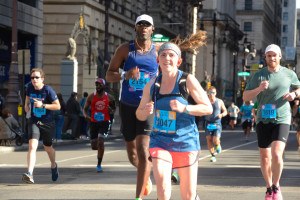Broad Street Run Training: Follow These 2 Simple Rules to Become a Better Runner
At face value, running seems like a very simple sport. All you need is a pair of shoes and the will to exhaust yourself and that’s it: You’re a runner. At the beginning, getting better is pretty simple, right? Just keep running. For the most part, the more you run, the better you’ll become.
However, at some point, the novelty of being a beginner wears off and you may find yourself struggling to improve. Then you’ll probably spend hours upon hours searching the Internet for anything running related in hopes of finding the secret to becoming a better runner. But the Internet is a deep black hole full of running knowledge and fads, some good, and some bad. So let me save you the trouble: I’m sorry to say, there is no one secret to running.
There is no one magic workout, no one training plan that’s best, no one form fix that will suddenly make you faster. Instead, the secret to running lies in a few golden rules that all good coaches and smart athletes follow. Elite runners live and train by these rules. These aren’t fads, but time-tested guidelines proven to produce results.
In my experience as a private running coach there are two rules — and they are perhaps the two most important rules — that many runners either don’t know about or simply ignore. But elite runners understand they must absolutely, 100 percent, adhere to them if they want to perform their best. Check out the two rules elite runners always follow (that you should follow, too!) below.
1. Elite runners know when and how to rest, and they do it.
This rule is non-negotiable and absolutely essential if you want to get better at running without getting injured. So listen up runners who try to beat their time on each run: You’re breaking this rule and it could be costing you.
The goal of training is to increase your body’s ability to handle greater levels of stress, mainly to maintain faster paces and run longer distances with less effort. The best way to achieve this is by stressing your body just beyond your current ability for a specific period of time, then resting to allow your body to heal. When done properly, during the healing process your body will begin to adapt to the higher stress and you’ll become fitter and able to handle faster pace and harder runs. This is called the stress/rest/adapt cycle. After each cycle, you’ll increase your body’s ability to handle higher stresses and, therefore, become fitter and faster.
Here’s what you can do: You’ll want to use this stress/rest/adapt cycle on a weekly, monthly and yearly basis. For weekly, look to only include two or three non-consecutive hard or long runs. Include at least one easy running, rest or cross training day after each hard or long run. The easy days must be run well under your current limit to allow the recovery and adaptation to take place. For example, elite runners will run between one and three minutes slower than race pace. For monthly, aim to include one week where your overall training load, usually measured by weekly mileage, is lower than the other three weeks. Yearly you’ll want to take planned breaks after each big race. Depending on the length of the race, aim to take three to 14 days off completely from running. And avoid going from one big race to another without planning some downtime.
2. Elite runners never neglect speed.
No matter what race distance they’re training for, elite runners always regularly include speed work. One study had elite marathon runners perform a 100-meter sprint to see if there was a positive correlation between 100 meter times and marathon times. Sure enough, the runner with the fastest 100-meter sprint had the fastest marathon time.
Here’s one reason why: Speed training engages your nervous system and muscle fibers in a way sub-maximal running cannot, resulting in a more efficient stride. The more efficient your stride the less energy you spend running at any given pace, and the easier that pace feels.
Here’s what you can do: Look to include some sort of speed work every week. You don’t want to run yourself into exhaustion by sprinting over and over, but instead do a few short (think: 10 to 45 seconds) sprints followed by ample jogging rest. I like to include one hard fast workout 12 days out from a race to wake up my system and prepare myself for the shock of racing. One idea: 4 x 1200 meters at 5K race pace with three minutes of jogging recovery in between sets.
……………
Cory Smith, a Philadelphia based running coach, shares his expert advice as an American Cancer Society DetermiNation running coach; founder of Run Your Personal Best, a private running-coaching business; and head cross country coach at Penn State Brandywine. He is a USA Track and Field-certified coach and a 4:03 miler. As a student athlete at Villanova, Cory was an NCAA Division One Regional and National Championship qualifier. Contact Cory at cory@runyourpersonalbest.com. Read all of Cory’s posts for Be Well Philly here.
Like what you’re reading? Stay in touch with Be Well Philly — here’s how:
- Like Be Well Philly on Facebook
- Follow Be Well Philly on Twitter
- Follow Be Well Philly on Pinterest
- Get the Be Well Philly Newsletter



